How To Decide on a New Handrail

Wooden handrails and other stylistic touches on and around staircases have a profound effect on the atmosphere of a home, which means they can be a very effective redecorating project or even a good way to improve the home’s appeal and value before resale. Since handrails require finish carpentry that takes a high degree of skill to put in place correctly, it’s a good idea to make this a project for a contractor. Before you find one, though, it helps to understand the anatomy of a handrail, because it makes it easier to have clear communication about what you want out of your upgrade.
Basic Parts of Hand Railings
Every wooden handrail that uses traditional designs has these basic parts:
- Balusters fit into the stairs side of the entire work, creating the base the newel posts connect to
- Newel posts connect the banister to the balusters
- The banister serves as the support for your hand, and they are designed for both comfort and ornamentation
These three parts of the handrail can be ornamented or stylized in thousands of ways, and when you combine that with a unique finish that fits the colors in your home, it’s easy to see how the right handrail can really finish the look of the house while providing a transition space between other design schemes.
Find a Professional Who Shares Your Vision
Carpentry is a skill that is equal parts science and art. The scientific part involves an understanding of the materials and their strengths and weaknesses, to construct a handrail with support to keep you safe that is also comfortable for the user. The art is in making it a truly stunning addition to your home. That artistry also means you will get very different results from different carpenters. That’s why it’s important to spend time getting to know the portfolio of a professional and interviewing them about their approach to your space. When you do, you’ll be able to find the professionals whose work reflects your own vision for the home.
